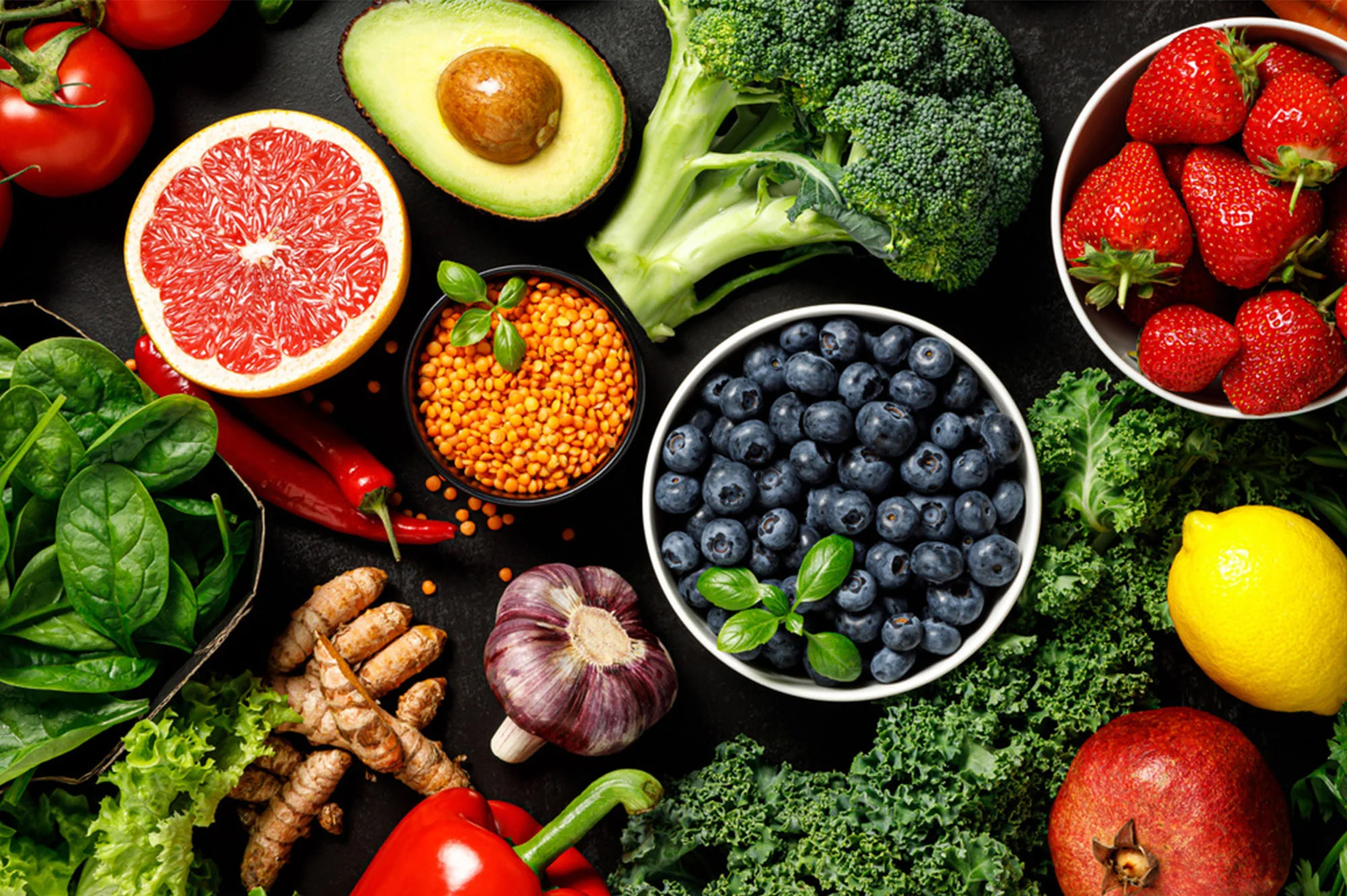Trying to eat better? You’re in good company! We’re big advocates for the importance of healthy eating, and fresh, tasty produce is one of the best ways to eat healthier. Still, some fruits and vegetables are especially healthy: Some are rich in vitamins and minerals, and some are jam-packed with nutrients like fiber and protein.
Getting more beneficial foods in your diet can help you live a happier, healthier life, and we’ve compiled a list of some of the healthiest fruits and vegetables to help you get there.
Finding the Healthiest Fruits and Vegetables to Eat
A healthy diet can look different from person to person. Some foods, however, are less nutritious than others. For example, foods with high amounts of sugar, saturated fats and trans fats can contribute to adverse health effects like obesity, heart problems and type 2 diabetes.
Diets that are rich in healthier ingredients typically have fewer risks associated with them. They often have a lot of nutrients, healthy fats and other helpful components that leave you feeling good.
Some qualities you might see in healthy fruits and vegetables include:
- Nutrients: Healthier foods are typically rich in vitamins and minerals, like vitamin B, iron and magnesium. They help power different functions in our bodies. Many fruits and vegetables offer a well-rounded collection of nutrients, while others provide hard-to-find ones.
- Healthy fats: Polyunsaturated and monounsaturated fats — also called healthy fats — are easier for our bodies to break down. Saturated and trans fats, however, are linked with heart disease. The good fats can keep your heart happy with a better impact on cholesterol. In fact, they’re necessary for bodily functions like blood clotting, proper inflammation and muscle movements. Healthy fats also help keep you full after a nice, balanced meal.
- Fiber: While fiber’s reputation is mainly related to its impact on bathroom habits, it also helps reduce risk for conditions like heart disease, diabetes and diverticular disease. Unfortunately, most Americans only get about half of their daily recommended intake. Adults should aim for 25-30 grams each day from food, but most people only get about 15. Many fruits and vegetables offer plenty of fiber. They can help fill the gap, keeping your belly and body moving smoothly.
- Antioxidants: Fruits and vegetables can also help you boost your intake of antioxidants. These molecules support your body in fighting free radicals, which are linked to conditions like diabetes and cancer.
7 Top Healthiest Fruits
Whether you’re trying to fight obesity, reduce inflammation or get more vitamins and nutrients, adding more fruit to your diet is a solid place to start. Many fruits pack a lot of nutrients into small, sweet and delicious packages. Fresh or frozen fruit is ideal, but canned fruit is also convenient. Just keep an eye out for added sugars in canned fruits, and opt for fruit canned in water or its own juice.
Try these nutritious fruits the next time you go shopping.
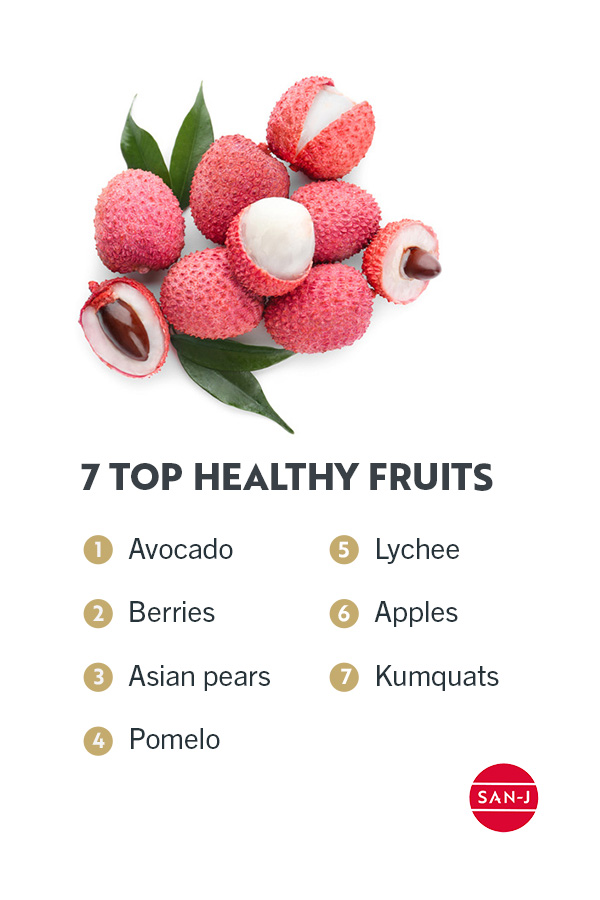
1. Avocado
The ever-popular avocado is a nutritional powerhouse. Just one Haas avocado has:
- 22 grams of mostly healthy fats.
- 10 grams of fiber.
- Many vitamins and minerals, including folate, potassium, and magnesium, as well as B vitamins and vitamins C, E, and K.
- Omega-3 fatty acids that can help with inflammation
Avocados are super versatile. A dash of your favorite seasonings, like paprika or balsamic vinegar, can turn a plain avocado into a delightful snack. You can also turn avocados into tasty guacamole — just make sure you pick the best avocados for the job. Salads, creamy soups, tacos, sandwiches and smoothies also pair well with these fruits. And, of course, we all know how delicious avocado toast is.
2. Berries
Many berries are packed with fiber and vitamin C. They also contain an inflammation-fighting antioxidant called polyphenols.
Some of the healthiest berries you can eat include:
- Blueberries: Aside from being delightfully easy to eat, blueberries offer many nutritional benefits. One cup of blueberries offers 24% of your daily value (DV) of vitamin K and 22% of your manganese. These little pockets of flavor are great for your heart health and insulin sensitivity. They also help fight inflammation.
- Raspberries: Raspberries are a very good source of fiber, helping you reach daily recommendations in a tasty way. They offer 8 grams of fiber per one-cup serving. They also have 36% of your daily vitamin C and manganese to keep your immune system and other bodily processes working well.
- Goji berries: Goji berries hail from China and, like raisins, are often eaten dry. Also like raisins, they make a perfect portable snack. One ounce of these sour dried berries offers 15% of your daily vitamin C, 42% of your vitamin A and 11% of your iron.
- Strawberries: A fan-favorite fruit is the sweet strawberry, and they’re just as nutritious as they are delicious. Just one cup of plump red strawberries has almost all your daily vitamin C, making it beneficial for your immune system. Studies have linked strawberries with reduced risks of heart disease and inflammation and improved blood sugar levels.
3. Asian Pears
Asian pears have the best of both worlds. They offer the crisp, refreshing crunch of an apple but the sweet flavor of a pear. Despite the name, Asian pears are easy to find in the United States. One pear offers 6 grams of fiber and substantial amounts of the following vitamins and minerals:
- Potassium
- Vitamin C
- Vitamin K
- Copper
- Folate
- Magnesium
It’s a great all-around fruit with a variety of nutrients.
4. Pomelo
If you don’t like the bitterness of grapefruit, try a pomelo. This translucent fruit from China has many of the same benefits as grapefruit but with a sweeter flavor. A peeled pomelo even offers some protein. It has 5 grams of protein, 6 grams of fiber and over four times your recommended DV of vitamin C. It also gives you 32% of your copper DV and 28% of your potassium DV. Many people use pomelos to help with digestion, maintaining weight and improving heart health.
5. Lychee
Lychee also comes from China, but you may have tasted it before. Many candies and juices use it for flavoring. As a fruit, lychee is sweet and flowery. It has a red peel and is slightly larger than a cherry. Just one of these fruits offers considerable vitamin C. It also has some copper, potassium and antioxidants.
6. Apples
The humble apple has several health benefits wrapped into a convenient, naturally portable package. One medium-sized apple gives you a little over 4 grams of fiber. More specifically, apples have a type of fiber called pectin that acts as a prebiotic to help your gut microbiome thrive. Apples also have beneficial antioxidants, including one called quercetin, which helps with immune function and reducing inflammation.
Apples come in many different varieties and work well in various dishes. Try pairing raw apples with peanut butter as a healthy snack or cooking them up with some cinnamon for a tasty dessert. You can even add a few slices to a sandwich or cook them into a sauce to go with meats.
7. Kumquats
You may not run into kumquats very often, but these tiny orange citrus fruits can help you eat a healthier diet. They’re small and oval, about 1-2 inches long, and hail from China. They have a sweet skin you can eat whole, and some varieties can be quite sour.
Kumquats are rich in vitamins C and A. Like many other items on our list of healthy fruits, kumquats have some fiber and antioxidants. While most people eat kumquats raw, you can also candy or pickle them or put them in a jam, jelly or marmalade.
7 Top Healthy Vegetables
Many vegetables contain plenty of vitamins to keep your body working its best. If you don’t eat meat, healthy vegetables are especially important for meeting certain nutritional needs. Iron and protein, for example, often come from meat sources, but some vegetables are high in these nutrients.
Try the following foods on our list of healthy vegetables to get more nutrients in your diet.
1. Leafy Greens
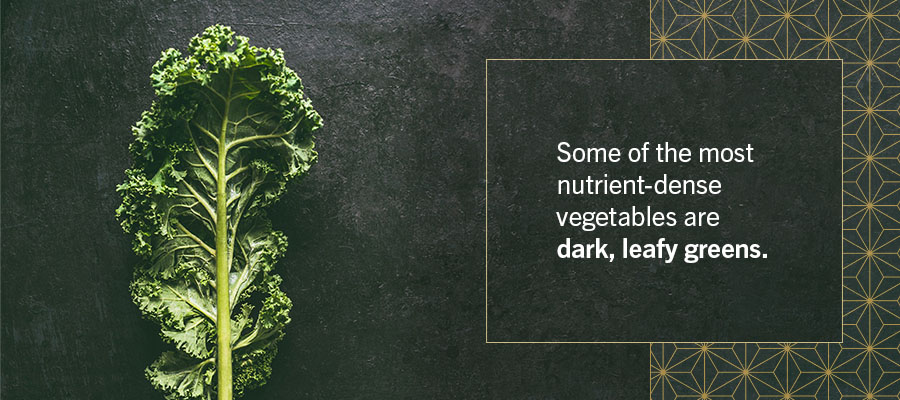
Some of the most nutrient-dense vegetables are dark, leafy greens, such as:
- Kale: Kale is packed with vitamin K, offering 684% of your DV in one cup! It has 206% of your DV for vitamin A and 134% of your DV for vitamin C. If you can get past its strong bitter flavor, kale offers several important nutrients.
- Spinach: The milder taste of spinach comes with 181% of your DV for vitamin K per cup. It also has decent amounts of vitamin A, manganese and folate. Spinach works well in various dishes, from lasagna to omelets. You can also prepare sauteed spinach on its own or add it to sandwiches and salads.
- Swiss chard: Swiss chard packs nutrients like potassium and manganese, as well as vitamins A, K and C. It may even help control blood sugar levels. Swiss chard can follow in spinach’s footsteps and works in many of the same recipes, such as soups and casseroles.
- Bok choy: Bok choy, a unique type of Chinese cabbage, is a great fit for soups and stir-fries. You can even make it the star of the show by roasting it with a hoisin-honey glaze. It has vitamins C, A and K and other useful nutrients, such as magnesium and potassium. Who knew a humble cabbage had so much to offer?
2. Broccoli
Broccoli, like many cruciferous vegetables, offers a range of vitamins and minerals to keep you healthy. A cup of raw broccoli boasts the following nutrients and benefits:
- 91% of your DV of vitamin C
- 77% of your DV of vitamin K
- 15% of your DV of folate
Broccoli also offers 2.2 grams of fiber and plenty of antioxidants to support healthy digestion and fight inflammation.
3. Legumes
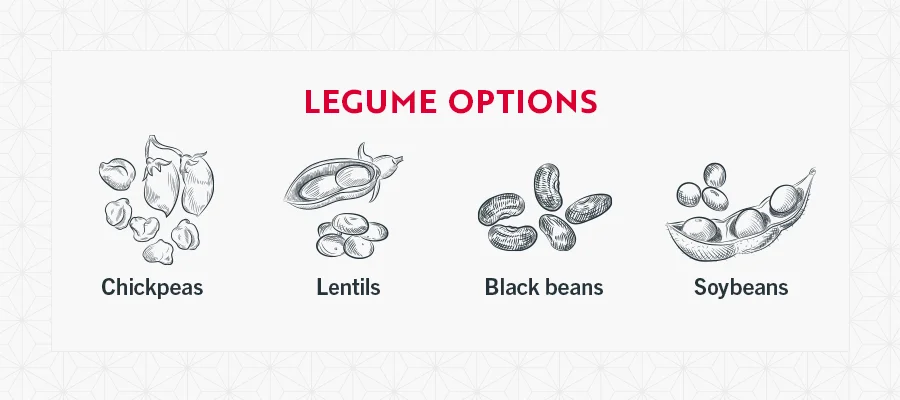
Legumes, which include beans and pulses, are another great choice of vegetable. They’re especially helpful if you want to increase your protein or fiber intake. Some legumes to choose from include:
- Chickpeas: Also called garbanzo beans, one cup of these little legumes offers an impressive 12.5 grams of fiber and 14.5 grams of protein. It also has 71% of your daily folate, 73% of your daily manganese and over a quarter of your daily iron. Chickpeas are ideal for creamy dips and spreads — and the perfect excuse for munching on pita chips. You can even roast them up and season them for a crispy snack.
- Lentils: Lentils aren’t as popular as some of their bean relatives, but they’re also packed with fiber, protein and vitamins. One cup gets you 17.9 grams of protein, 15.6 grams of fiber, 90% of your daily folate and 37% of your daily iron. Lentils can also help improve blood sugar and cholesterol. They mix up exceptionally well in soups, plant-based burgers, pasta sauces and much more.
- Black beans: Black beans are also an excellent source of fiber and protein, and they contain decent amounts of folate, thiamine, iron, magnesium and manganese. Use them in dips, burritos or tasty plant-based burgers for a nutrient-packed meat replacement. You can even sneak them into some dessert recipes to make these treats a little healthier.
- Soybeans: Soybeans offer riboflavin, folate, vitamin K, manganese and iron. You might not see them in their bean form very often, but soybeans are popular in many plant-based products like tofu.
Other legumes to eat include pinto beans, peas, kidney beans and peanuts. Remember to watch out for pesky added sugar if you opt for canned beans.
4. Daikon Radish
The Daikon radish is native to China and Japan and is a staple of Asian cuisines. It is available at many grocery stores, but if you cannot find it, you might need to head to an Asian grocery store to find it and a daikon radish is worth the trip. You’ll find it cooked in stir fries, sliced or grated as a garnish, added to flavorful soups, eaten raw or even pickled. Daikon radishes are particularly versatile, with a mild flavor and a slightly sweet taste when cooked. They’re rich in these nutrients:
- Folate
- Potassium
- Magnesium
- Vitamin C
- Fiber
5. Taro Root
Taro root is one of the oldest cultivated plants, popular in dishes around the world. It has a bright purple color that adds a pop of brightness to many dishes, like poi, a Hawaiian food similar to mashed potatoes. With its mild, slightly nutty flavor, taro root pairs well with various ingredients. You should never eat it raw, however, as a compound in the root can cause your mouth and throat to itch. It’s perfectly safe to eat once cooked.
The taro root is rich in antioxidants, manganese, vitamins B6 and E, potassium, and copper. Its 4 grams of fiber per cup make it a good choice for improving digestion and managing blood sugar.
You can cook taro root with methods like boiling, roasting, stir-frying and baking. Try making taro root fries, grating it into baked goods or slicing it up into chips.
6. Carrots
Carrots are another versatile ingredient full of health benefits. One cup of carrots gives you 119% of your daily vitamin A, as well as other nutrients like potassium, fiber, and vitamins K and C. Carrots get their characteristic orange color from beta carotene.
Carrots work well in snacks, meals and even desserts. You could pair carrots with SAN-J Thai Peanut Sauce for a balanced afternoon treat or grate them into a stir-fry for a savory dinner. These vegetables often take on the flavors of other ingredients while offering a nice texture, making them a kitchen staple for many cooks.
7. Sweet Potatoes
The same compound that gives carrots their bright color also makes sweet potatoes orange. Sweet potatoes, also called yams, are high in fiber and rich in vitamins A and C and potassium. They also have several antioxidants. Deeper colors of sweet potatoes, such as purple and deep orange varieties, tend to show higher antioxidant levels.
Sweet potatoes are nearly as versatile as regular potatoes. You can mash them, add them to stir-fries, roast them with a sweet sauce or make sweet potato fries.
Add Healthy Fruits and Vegetables to Any Dish With SAN-J
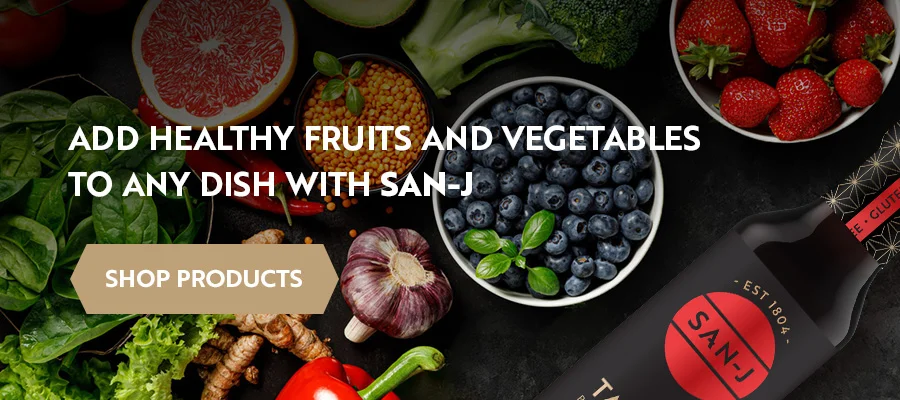
Adding unprocessed fruits and vegetables to your diet is an excellent approach to eating healthier. Whether you want to increase your fiber intake, reduce your risk of chronic diseases or meet another health goal, good produce helps immensely. With a little creativity, you can incorporate these healthy fruits and vegetables into many tasty dishes, especially those from Asian cuisine.
At SAN-J, we offer premium Tamari, cooking sauces, soups and other products to help you make the most of your produce. You can reap all the health benefits in delicious meals and snacks, supported by high-quality ingredients and processes. Learn more about our products, or explore our recipe collection to get inspired!
Back to Top
